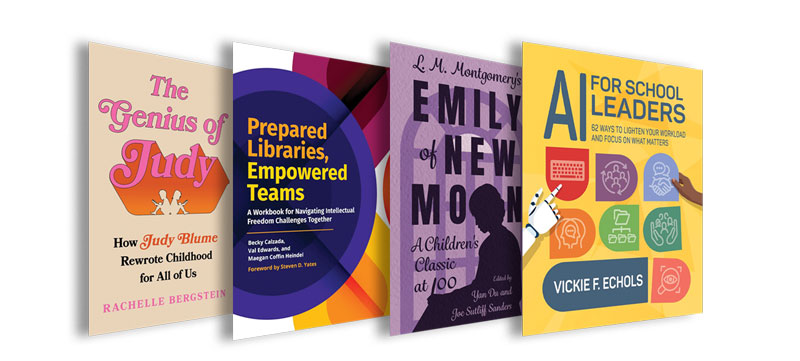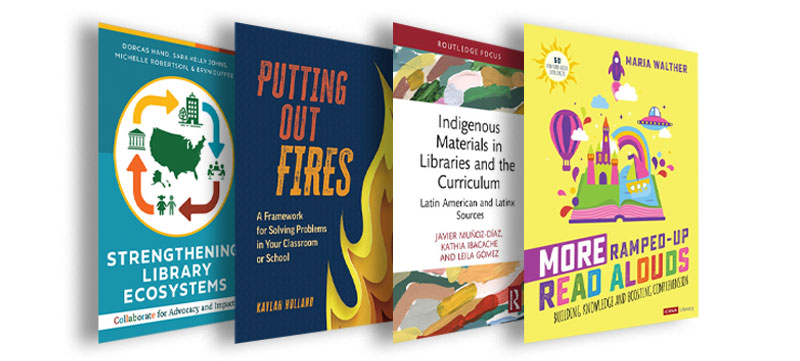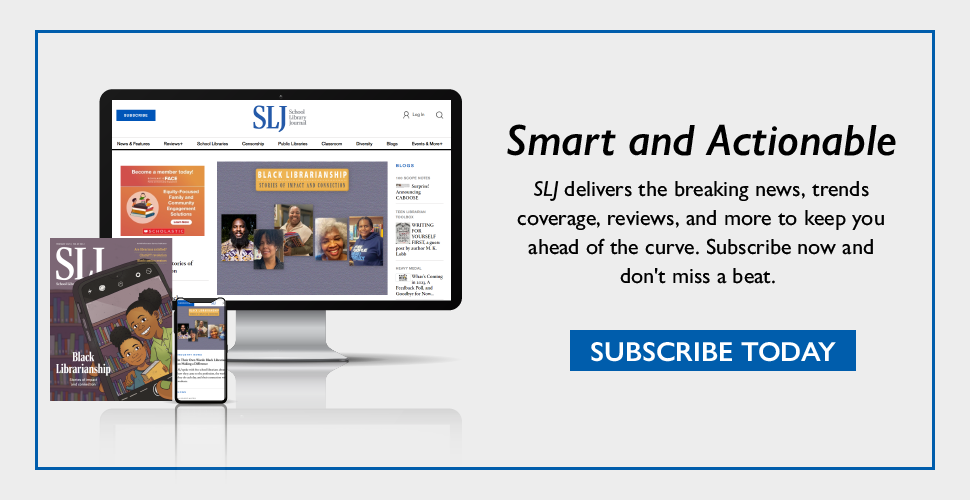8 Professional Reading Titles to Help Librarians in the New Year
These books on topics ranging from using AI successfully to navigating book challenges are a good place for librarians to start as they look toward another year of positively influencing young readers.

 Bergstein, Rachelle. The Genius of Judy: How Judy Blume Rewrote Childhood for All of Us. 288p. Atria/One Signal. Jul. 2024. Tr $28.99. ISBN 9781668010907.
Bergstein, Rachelle. The Genius of Judy: How Judy Blume Rewrote Childhood for All of Us. 288p. Atria/One Signal. Jul. 2024. Tr $28.99. ISBN 9781668010907.
Judy Blume has an unshakable presence in the adolescence of many folks, with writing that now holds a place of nostalgia. Bergstein’s new biography offers a perfect blend of that connection juxtaposed against details from Blume’s life that offer insight on her career and, perhaps more importantly, her individual self. Details from interviews, newspaper clippings, and other primary documents are the heart of the text, and Bergstein expertly creates a cohesive whole out of this tapestry of sources. Weaving together details of Blume’s growing career with the complexities of her family relationships and the evolving political climate that provides the ongoing context for her writing, Bergstein has crafted something intimate and expansive, with the perfect mix of looking back in order to point a way forward. The censorship Blume faced early in her career is brought into conversation with current efforts to limit reading choices as well noting her continued presence as a feminist voice speaking up for young readers. This makes what could feel like a niche nostalgic work into a text with urgency and wide appeal. VERDICT An excellent purchase for school and public library collections.–Jen McConnel
 Calzada, Becky, Val Edwards & Maegan Coffin Heindel. Prepared Libraries, Empowered Teams: A Workbook for Navigating Intellectual Freedom Challenges Together. 104p. ALA Editions. Jul. 2024. pap.$34.99. ISBN 9798892555371.
Calzada, Becky, Val Edwards & Maegan Coffin Heindel. Prepared Libraries, Empowered Teams: A Workbook for Navigating Intellectual Freedom Challenges Together. 104p. ALA Editions. Jul. 2024. pap.$34.99. ISBN 9798892555371.
This title provides helpful, practical information on the background and proliferation of book challenges. The authors clearly set out to condense and summarize a practical roadmap for library administrators to prepare and train their staff for the organized efforts of many conservative groups to remove books from libraries. The book opens with a summation of the current situation and how the number of challenges has dramatically risen in the last few years; the authors then discuss how to develop a strong policy and get support from library trustees and other potential stakeholders. While this book will be helpful to public libraries, school libraries are mentioned throughout as well, with information and resources for librarians working in the educational environment. Bar graphs interspersed with visual statistics throughout the text make this a relatively quick read that will help any librarian make a case for why book challenges are so important to address proactively. The final chapter, which speaks about applying some of the practical guidelines to specific situations, is a true highlight. Library staff could be put through book challenge “drills” that effectively provide a way to roleplay as individuals coming into the library for the express purpose of trying to remove books that they don’t like. VERDICT Highly recommended.–Ryan P. Donovan
Du, Yan & Joe Sutliff Sanders, eds. L.M. Montgomery’s Emily of New Moon: A Children’s Classic at 100. 232p. (Children’s Literature Association). Univ. of Mississippi. Apr. 2024. pap. $30. ISBN 9781496852502.
Lucy Maud Montgomery’s “Emily of New Moon” series turned 100 years old in 2023, and this academic work was published in celebration. Not as well-known as the Canadian author’s classic Anne of Green Gables, the trilogy follows the life of a sensitive orphan who aspires to be a writer and must navigate the trauma and drama she undergoes with relatives who don’t appreciate her pursuits. Montgomery began writing the first volume while in the middle of a legal battle with the U.S. publisher of Anne and as her family life started to deteriorate. “Emily represented to Montgomery a chance to renegotiate her childhood, professional career, and personal relationships,” say the editors in the introduction to this work. Montgomery shared that Emily’s story was more autobiographical than Anne’s, and scholars have found that it is the more melancholic and mature of the two series. Du and Sanders divided the work into four parts—Literary Resonances, Emily’s Things, Gender, and Time. In 12 essays, approximately 15 pages each, academics analyze gender roles in the novels, the book’s reception, how “mothering” plays out in the books, and more. Yoshiko Akamatsu’s offering compares how the “Emily” books were received in Japan where the “Anne” series is super popular. Kate Lawson’s entry places Emily of New Moon within the context of Victorian history, when the novels most likely are set. Every chapter is followed by notes and works cited. VERDICT A scholarly work more at home in academic libraries for those studying the impact of classic children’s literature and for superfans of Montgomery’s work.–Shelley M. Diaz
Echols, Vickie F. AI for School Leaders: 62 Ways to Lighten Your Workload and Focus on What Matters. 192p. ISTE. Oct. 2024. pap. $37.99. ISBN 9798888370322.
A guide for effectively using artificial intelligence (AI) to ease some of the pressures felt by school leaders. The author references many current research studies that demonstrate the high levels of performance and stress that school leaders face as they try to meet the expectations of today’s world. Echols argues that by learning to use AI, school leaders will reduce the time required to complete repetitive administrative tasks and gain time for relationship building and personal well-being. Readers learn about generative AI in Chapter One, and Echols identifies how to write and frame AI prompts to generate maximum positive results. Using AI safely is a natural extension that Echols details in Chapter Two. With various dilemmas presented to ponder, the author offers scenario solutions with options for particular circumstances to help guide school leaders in addressing their particular issues. Chapters Three through Seven offer more than 60 practical uses for AI by school leaders aligned to the ISTE Education Leader standards. Chapter topics include collaborative decision-making, supportive relationships and trust, personalized professional learning, data management and school improvement, and family and community engagement. These chapters are all arranged similarly: each topic covers a problem, its solution, and an example of a prompt to use with AI. Some also discuss acceleration and cautionary aspects. The highlight of each chapter is the step-by-step creation of appropriate prompts that elicit the information requested. Questions at the end of each chapter help deepen understanding through reflection and conversation, and back matter includes AI resources, a glossary, references, and an index. VERDICT A professional purchase for most school libraries.–Susan Catlett

Hand, Dorcas, Sara Kelly Johns, Michelle Robertson & Eryn Duffee. Strengthening Library Ecosystems: Collaborate for Advocacy and Impact. 272p. ALA Editions. Jul. 2024. pap. $54.99. ISBN 9798892555722.
A thorough guide for library professionals looking to enhance collaboration and network with other libraries. The authors begin by explaining the concept of a library ecosystem and highlighting the shared traits that connect all types of libraries. Then the next section details the key components of ecosystem thinking: leadership, communication, collaboration, and sustainability. In the following chapters, practical applications of these ideas are explored, particularly in the context of advocacy and combating censorship. The book’s approach is not limited to just theory; it offers real-world case studies that demonstrate both the success of collaborative ecosystems and the challenges of working in isolation. Additionally, the text emphasizes the importance of recognizing the differences and shared goals between various types of libraries—school, public, academic—and related groups, such as trustees and foundations. With detailed examples, resources, and a comprehensive exploration of the topic, this work serves as a valuable tool for library science students and professionals seeking to build stronger networks within the field. VERDICT A good resource that offers detailed insights and practical examples on how to strengthen advocacy and collaboration through ecosystem thinking.–Christina Salazar
Holland, Kaylah. Putting Out Fires: A Framework for Solving Problems in Your Classroom or School. 152p. ISTE. Aug. 2024. pap. $32.99. ISBN 9798888370285.
Educators are constantly addressing chronic problems with short-term resolutions due to a lack of time and resources for planning. Holland has assembled a framework for school staff to anticipate issues and brainstorm solutions in advance. The book has an educational technology undercurrent: examples within relate to technology, but suggested exercises stem from the author’s experience in both ed tech and with students in secure schools in the U.S. Juvenile Justice System. Prevent, Detect, Contain, and Extinguish are the pillars of the framework. End-of-chapter activities have two branches: one for educators and one for school administrators. Both center design thinking, encouraging readers to focus on people, technology integration, and economic impact. Readers are prompted to employ logic and feelings to examine facets of problems and consider barriers, impacts on individuals and groups, and their own capacity and influence to implement solutions. A QR code to the author’s spoken explanations accompanies each module. Teachers and administrators pursuing small group study or a schoolwide development title will find that the book presents more opportunities for introspection than quick tips or fixes. VERDICT School libraries will find this a helpful addition to a well-used professional collection.–Deidre Winterhalter
 Muñoz-Díaz, Javier, Kathia Ibacache & Leila Gómez. Indigenous Materials in Libraries and the Curriculum: Latin American and Latinx Sources.100p. (Routledge Focus). Routledge. Apr. 2024. Tr $64.99. ISBN 9781032618494.
Muñoz-Díaz, Javier, Kathia Ibacache & Leila Gómez. Indigenous Materials in Libraries and the Curriculum: Latin American and Latinx Sources.100p. (Routledge Focus). Routledge. Apr. 2024. Tr $64.99. ISBN 9781032618494.
This title calls readers to take a decolonizing approach toward library collections and their distribution, noting that the university library is often a site that maintains Eurocentric extraction and objectification patterns from which educators, researchers, and students learn and create new knowledge about Indigenous people, particularly those from Latin America. Instead, the authors call for centering the languages, literacies, and creative literary and media work of Indigenous people to build and expand awareness of their epistemologies or ways of knowing. The goal goes beyond simply increasing the quantity of materials produced by Indigenous people in collections; it is also to analyze library systems, distribution processes, and reception or engagement efforts to identify the colonizing cultural and epistemological values these uphold. To do this, the authors present ways to build bridges and increase networks among academic librarians, faculty, students, and Indigenous communities. These include examples of faculty/librarian collaborations to build physically and digitally inclusive collections, recommendations for text selection criteria, and ways to catalog collections that link to broader social networks and small publishing companies. All of this allows for easier search processes, identification, and location of these materials to create new knowledge with, rather than for or about, Indigenous people. VERDICT A crucial title for all academic libraries; this should be required reading in graduate library science, education, and higher education programs across the U.S.–Ruth Quiroa
Walther, Maria. More Ramped-Up Read Alouds: Building Knowledge and Boosting Comprehension. 240p. (Corwin Literacy). Corwin. Aug. 2024. pap. $34.95. ISBN 9781071931240.
Walther’s newest title provides practitioners with 50 new and innovative read-aloud experiences for the elementary school classroom. Before getting into the titles, Walther presents thorough evidence in support of read-alouds across disciplines and age groups, including evidence-based research on the importance of interactive read-alouds and tips for successful classroom use. The read-aloud experiences are grouped into five thematic areas: classroom climate, foundational reading skills, listening comprehension, STEAM topics, and writing integration. Each read-aloud experience is presented in two spreads that provides everything an instructor could need to employ it, from a short summary, to learning targets, to example prompts and recommendations for “comprehension conversations” at all stages of the reading process. For recommended classroom activities, either a template or exemplar is provided, as well as suggestions of similar titles (at least two per title), exponentially expanding the possibilities for instructors using this text. Back matter includes an appendix of text sets, a bibliography that includes professional and children’s literature references, and an index. The consistent formatting and clear labeling of read-aloud elements make this book easy to reference for a quick lesson idea but the in-depth justification from research makes it a valuable long read as well. VERDICT A necessary purchase for elementary professional collections; the read-aloud experiences included provide a wealth of ideas to utilize across content areas and grade levels.–Mary Kamela
Add Comment :-
RELATED
The job outlook in 2030: Librarians will be in demand
The job outlook in 2030: Librarians will be in demand
ALREADY A SUBSCRIBER? LOG IN
We are currently offering this content for free. Sign up now to activate your personal profile, where you can save articles for future viewing





